

Halesia tetraptera - (image 1 of 5)
Taxonomy
Family: Styracaceae
Habitat
Well-drained, moist, acid (pH 5 to 6), high organic matter soils in sun or part-shade. Often occurs as an understory tree on wooded slopes and along streams.
Associates
.
Distribution
Common in the southern Appalachians. The range is almost a diagonal line from TX northeast into NY, plus MI, SC, NC, VA, and GA.
Morphology
Medium tree, to 40' in height and 30' in width, but can potentially grow to 100'. Leaves deciduous, alternate, simple, ovate or elliptic to ovate-oblong, to 5" long, about half as wide, acuminate, rounded at base, serrulate to almost entire, glabrous when mature, petiole to .5" long. Terminal bud absent, laterals buds ovate, acute, scaley, brown to dark red-brown. Stems slender, glabrous to densely pubescent, brown; pith white and chambered; stems become stringy on two year wood. Flowers white to pale pink, bell-shaped, to 1" long, shallowly 4 lobed, perfect, on pendulous stalks in axillary clusters of 2-5 on the previous year's growth. Fruit a dry, 4-winged drupe, containing 2 to 3 seeds.
Notes
Flowers April into early May
Wetland indicator: NA
The specific epithet refers to the 4-sided drupes (tetra = four). Suitable as an ornamental and not very common; actually rather expensive and hard to find in some areas. The pictures here are of a pink-flowered cultivar, perhaps 'Rosea'. Easily overlooked from a distance, the individual flowers are charming close-up. Hardy to zone 4. There are two botanical varieties of this species, H. tetraptera var. tetraptera and H. tetraptera var. monticola (Rehd.) Reveal & Seldin (Formerly H. monticola (Rehd.) Sarg.).
Bibliography
Dirr, Michael A. 1998. Manual of Woody Landscape Plants:
Their Identification, Ornamental Characteristics, Culture, Propagation and Uses.
5th ed. Champaign, Illiois: Stipes Publishing L.L.C.
USDA, NRCS. 2002.
The PLANTS Database, Version 3.5 (http://plants.usda.gov).
National Plant Data Center, Baton Rouge, LA 70874-4490 USA.
|
Michael Hough © 2005 |